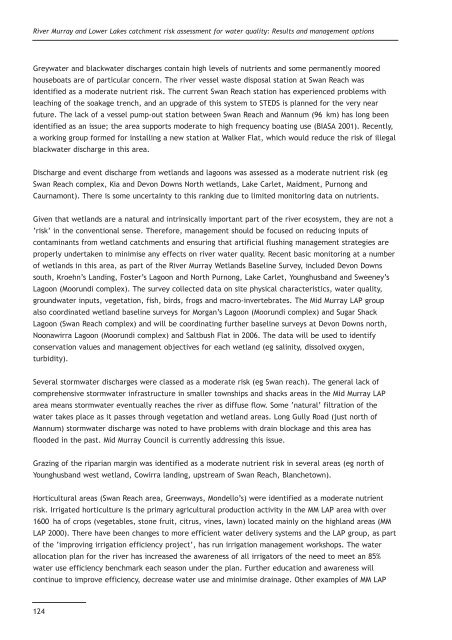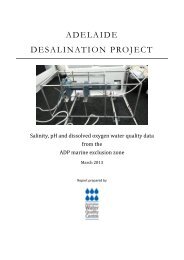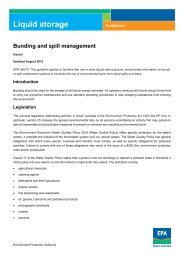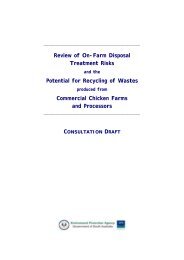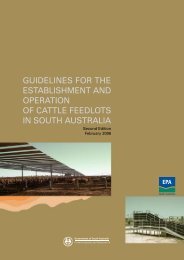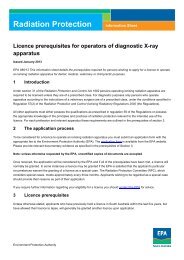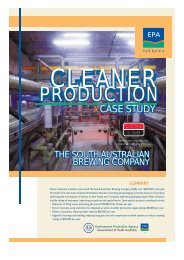2 Renmark to border LAP area assessment - EPA - Sa.gov.au
2 Renmark to border LAP area assessment - EPA - Sa.gov.au
2 Renmark to border LAP area assessment - EPA - Sa.gov.au
Create successful ePaper yourself
Turn your PDF publications into a flip-book with our unique Google optimized e-Paper software.
River Murray and Lower Lakes catchment risk <strong>assessment</strong> for water quality: Results and management options<br />
Greywater and blackwater discharges contain high levels of nutrients and some permanently moored<br />
houseboats are of particular concern. The river vessel waste disposal station at Swan Reach was<br />
identified as a moderate nutrient risk. The current Swan Reach station has experienced problems with<br />
leaching of the soakage trench, and an upgrade of this system <strong>to</strong> STEDS is planned for the very near<br />
future. The lack of a vessel pump-out station between Swan Reach and Mannum (96 km) has long been<br />
identified as an issue; the <strong>area</strong> supports moderate <strong>to</strong> high frequency boating use (BIASA 2001). Recently,<br />
a working group formed for installing a new station at Walker Flat, which would reduce the risk of illegal<br />
blackwater discharge in this <strong>area</strong>.<br />
Discharge and event discharge from wetlands and lagoons was assessed as a moderate nutrient risk (eg<br />
Swan Reach complex, Kia and Devon Downs North wetlands, Lake Carlet, Maidment, Purnong and<br />
C<strong>au</strong>rnamont). There is some uncertainty <strong>to</strong> this ranking due <strong>to</strong> limited moni<strong>to</strong>ring data on nutrients.<br />
Given that wetlands are a natural and intrinsically important part of the river ecosystem, they are not a<br />
‘risk’ in the conventional sense. Therefore, management should be focused on reducing inputs of<br />
contaminants from wetland catchments and ensuring that artificial flushing management strategies are<br />
properly undertaken <strong>to</strong> minimise any effects on river water quality. Recent basic moni<strong>to</strong>ring at a number<br />
of wetlands in this <strong>area</strong>, as part of the River Murray Wetlands Baseline Survey, included Devon Downs<br />
south, Kroehn’s Landing, Foster’s Lagoon and North Purnong, Lake Carlet, Younghusband and Sweeney’s<br />
Lagoon (Moorundi complex). The survey collected data on site physical characteristics, water quality,<br />
groundwater inputs, vegetation, fish, birds, frogs and macro-invertebrates. The Mid Murray <strong>LAP</strong> group<br />
also coordinated wetland baseline surveys for Morgan’s Lagoon (Moorundi complex) and Sugar Shack<br />
Lagoon (Swan Reach complex) and will be coordinating further baseline surveys at Devon Downs north,<br />
Noonawirra Lagoon (Moorundi complex) and <strong>Sa</strong>ltbush Flat in 2006. The data will be used <strong>to</strong> identify<br />
conservation values and management objectives for each wetland (eg salinity, dissolved oxygen,<br />
turbidity).<br />
Several s<strong>to</strong>rmwater discharges were classed as a moderate risk (eg Swan reach). The general lack of<br />
comprehensive s<strong>to</strong>rmwater infrastructure in smaller <strong>to</strong>wnships and shacks <strong>area</strong>s in the Mid Murray <strong>LAP</strong><br />
<strong>area</strong> means s<strong>to</strong>rmwater eventually reaches the river as diffuse flow. Some ‘natural’ filtration of the<br />
water takes place as it passes through vegetation and wetland <strong>area</strong>s. Long Gully Road (just north of<br />
Mannum) s<strong>to</strong>rmwater discharge was noted <strong>to</strong> have problems with drain blockage and this <strong>area</strong> has<br />
flooded in the past. Mid Murray Council is currently addressing this issue.<br />
Grazing of the riparian margin was identified as a moderate nutrient risk in several <strong>area</strong>s (eg north of<br />
Younghusband west wetland, Cowirra landing, upstream of Swan Reach, Blanche<strong>to</strong>wn).<br />
Horticultural <strong>area</strong>s (Swan Reach <strong>area</strong>, Greenways, Mondello’s) were identified as a moderate nutrient<br />
risk. Irrigated horticulture is the primary agricultural production activity in the MM <strong>LAP</strong> <strong>area</strong> with over<br />
1600 ha of crops (vegetables, s<strong>to</strong>ne fruit, citrus, vines, lawn) located mainly on the highland <strong>area</strong>s (MM<br />
<strong>LAP</strong> 2000). There have been changes <strong>to</strong> more efficient water delivery systems and the <strong>LAP</strong> group, as part<br />
of the ‘improving irrigation efficiency project’, has run irrigation management workshops. The water<br />
allocation plan for the river has increased the awareness of all irriga<strong>to</strong>rs of the need <strong>to</strong> meet an 85%<br />
water use efficiency benchmark each season under the plan. Further education and awareness will<br />
continue <strong>to</strong> improve efficiency, decrease water use and minimise drainage. Other examples of MM <strong>LAP</strong><br />
124


